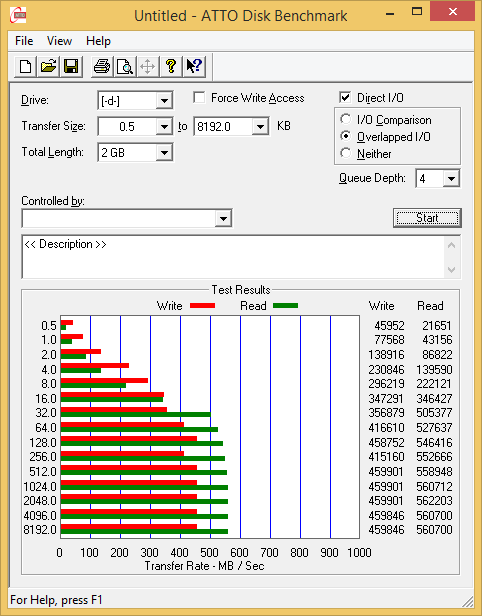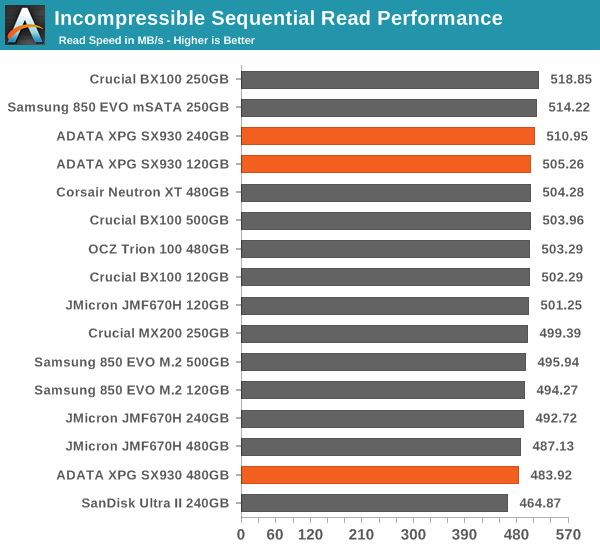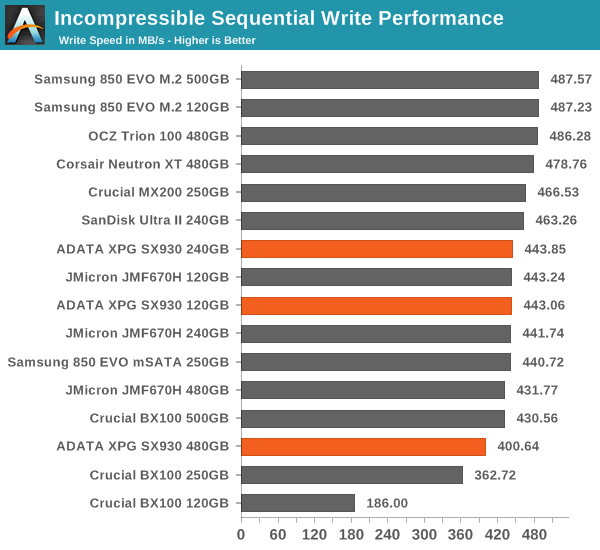ADATA XPG SX930 (120GB, 240GB & 480GB) SSD Review: JMicron JMF670H Debuts
by Kristian Vättö on July 16, 2015 10:00 AM ESTATTO - Transfer Size vs Performance
ATTO is a handy tool for quickly measuring performance across various transfer sizes and it's also freeware that can easily be run by the end-user.
 |
|||||||||
AS-SSD Incompressible Sequential Performance
Similar to ATTO, AS-SSD is freeware as well and uses incompressible data for all of its transfers, making it a valuable tool when testing drives with built-in compression engines (e.g. SandForce).












67 Comments
View All Comments
dada121 - Thursday, July 16, 2015 - link
First to take the throne,Refuge - Thursday, July 16, 2015 - link
can't wait for NVMe to give us some space to stretch our legs again! :)Stochastic - Thursday, July 16, 2015 - link
Just how much of an impact are NVMe drives expected to have on light tasks, e.g. boot times, application and game load times, etc. Could the average consumer benefit from a move to ultra high performance NVMe drives, or are the benefits limited to power users?Refuge - Thursday, July 16, 2015 - link
It is definitely more limited to power users. Especially until NVMe support and drives go down in costs. Right now it is enterprise or enthusiast only.But that is just par for the course. Software will be developed to use the extra horsepower one day, but not until after that level of performance is much more common place.
SATA6 SSD's will be perfect for regular consumers for years to come. But I see in a couple years especially with how graphics resolutions are going through the roof that Gamers will start finding a use for the extra bandwidth once 4k gaming is mainstream and texture packs start to explode like they did back in the 90's.
Remember when a 16g HDD running at 5400 RPM was the SHIT!?
TelstarTOS - Tuesday, July 21, 2015 - link
Yeah, in those times i had SCSI :)Adding-Color - Thursday, July 16, 2015 - link
They could be useful for video editing and other stuff that profits from fast sequential reads/writes.For games not so much. Most games appear to be CPU limited not SSD disk limited (for load times, when you are using a SSD) and a recent review (forgot the link) showed almost no load times improvement using a 2GB/s NVME Pcie SSD compared to a 500MB/s SATA SSD.
From a power and and efficiency standpoint NVME should have less latency and less lower consumption.
Impulses - Thursday, July 16, 2015 - link
Content creation tasks, even with photos instead of video, can already benefit greatly from NVMe or M2/PCI-E in general... I'm getting a smaller M2 Samsung drive as soon as I have a mobo that supports it (Skylake?), not sure I see myself going for a large one until prices drop well under $1/GB tho, and that'll take a while.For a power user I think an M2/PCI-E SSD for OS/apps/scratch space + large SATA SSD drive/array for data will soon supplant the SATA SSD + HDD setups... But M2/PCI-E will be like the Raptors of the SSD world.
AnnonymousCoward - Thursday, July 16, 2015 - link
Stochastic, you won't find the answer here, since AT doesn't do real world SSD testing.benzosaurus - Sunday, July 19, 2015 - link
Half of their benchmarks are literally recordings of the writes generated by doing real world things.AnnonymousCoward - Sunday, July 19, 2015 - link
Irrelevant. Stochastic asked how boot times and app load times compare.